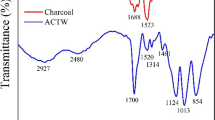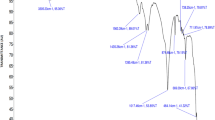Abstract
Pulsed discharge plasma (PDP) combined with charcoal (PDP–charcoal) was employed to treat dye wastewater, with methyl orange (MO) as the model pollutant. The charcoal was prepared using spent tea leaves and was characterized by scanning electron microscopy, Fourier-transform infrared spectroscopy, and Boehm titration to investigate the adsorption and catalytic characteristics before and after adsorption and PDP treatment. The prepared charcoal exhibited a high MO adsorption capacity, and the adsorption process followed the pseudo-second-order kinetic model and the Freundlich model. The MO decoloration efficiency reached 69.8 % within 7.5 min of treatment in the PDP–charcoal system, whereas values of 29.2 and 25.9 % were achieved in individual PDP and charcoal systems, respectively. The addition of n-butanol and H2PO4 − presented inhibitive effects on MO decoloration in the PDP system. However, these effects were much weaker in the PDP–charcoal system. In addition, the effects of charcoal on O3 and H2O2 formation were evaluated, and the results showed that both the O3 and H2O2 concentrations decreased in the presence of charcoal. The MO decomposition intermediates were analyzed using UV–Vis spectrometry and GC-MS. 1,4-Benzoquinone, 4-nitrophenol, 4-hydroxyaniline, and N,N′-dimethylaniline were detected. A possible pathway for MO decomposition in this system was proposed.











Similar content being viewed by others
References
Akar E, Altinisik A, Seki Y (2013) Using of activated carbon produced from spent tea leaves for the removal of malachite green from aqueous solution. Ecol Eng 52:19–27
Amore Pacific Crop (2010) Green tea—a global strategic business report. Global Industry Analysts, San Jose
Anandkumar J, Mandal B (2009) Removal of Cr(VI) from aqueous solution using Bael fruit (Aegle marmelos correa) shell as an adsorbent. J Hazard Mater 168:633–640
Auta M, Hameed BH (2011) Preparation of waste tea activated carbon using potassium acetate as an activating agent for adsorption of acid blue 25 dye. Chem Eng J 171:502–509
Bian WJ, Lei LC (2007) An electrohydraulic discharge system of salt-resistance for p-chlorophenol degradation. J Hazard Mater 148:178–184
Buxton GV, Greenstock CL, Helman WP (1988) Critical review of rate constants for reactions of hydrated electrons, hydrogen atoms and hydroxyl radicals in aqueous solution. J Phys Chem Ref Data 17:513–886
Chidambaram T, Oren Y, Noel M (2015) Fouling of nanofiltration membranes by dyes during brine recovery from textile dye bath wastewater. Chem Eng J 262:156–168
Faria PCC, Orfao JJM, Pereira MFR (2008) Activated carbon catalytic ozonation of oxamic and oxalic acids. Appl Catal B Environ 79:237–243
Georgi A, Kopinke FD (2005) Interaction of adsorption and catalytic reactions in water decontamination processes: part I oxidation of organic contaminants with hydrogen peroxide catalyzed by activated carbon. Appl Catal B Environ 58:9–18
Gundogdu A, Duran C, Senturk HB, Soylak M, Imamoglu M, Onal Y (2013) Physicochemical characteristics of a novel activated carbon produced from tea industry waste. J Anal Appl Pyrolsis 104:249–259
Hao XL, Zhang XW, Lei LC (2009) Degradation characteristics of toxic contaminant with modified activated carbons in aqueous pulsed discharge plasma process. Carbon 47:153–161
Hong PKA, Zeng Y (2002) Degradation of pentachlorophenol by ozonation and biodegradability of intermediates. Water Res 36:4243–4254
Hou MF, Li FB, Liu XM, Wang XG, Wan HF (2007) The effect of substituent groups on the reductive degradation of azo dyes by zerovalent iron. J Hazard Mater 145:305–314
Jain AK, Gupta VK, Bhatnagar A, Suhas (2003) A comparative study of adsorbents prepared from industrial wastes for removal of dyes. Sep Sci Technol 38:463–481
Kasprzyk-Hordern B, Ziolek M, Nawrocki J (2003) Catalytic ozonation and methods of enhancing molecular ozone reactions in water treatment. Appl Catal B Environ 46:639–669
Leitner NKV, Syoen G, Romat H, Urashima K, Chang JS (2005) Generation of active entities by the pulsed arc electrohydraulic discharge system and application to removal of atrazine. Water Res 39:4705–4714
Liu D, Yuan WW, Yuan P, Yu WB, Tan DY, Liu HM, He HP (2013) Physical activation of diatomite-templated carbons and its effect on the adsorption of methylene blue (MB). Appl Surf Sci 282:838–843
Lu XF, Ma HR, Zhang Q, Du K (2013) Degradation of methyl orange by UV, O3 and UV/O3 systems: analysis of the degradation effects and mineralization mechanism. Res Chem Intermed 39:4189–4203
Marcelino RBP, Queiroz MTA, Amorim CC, Leao MMD, Brites-Nobrega FF (2015) Solar energy for wastewater treatment: review of international technologies and their applicability in Brazil. Environ Sci Pollut Res 22:762–773
Martins RC, Quinta-Ferreira RM (2009) Catalytic ozonation of phenolic acids over a Mn-Ce-O catalyst. Appl Catal B Environ 90:268–277
Mittal A, Mittal J, Malviya A, Kaur D, Gupta VK (2010) Decoloration treatment of a hazardous triarylmethane dye, Light Green SF (Yellowish) by waste material adsorbents. J Colloid Interface Sci 342:518–527
Mukimin A, Vistanty H, Zen N (2015) Oxidation of textile wastewater using cylinder Ti/beta-PbO2 electrode in electrocatalytic tube reactor. Chem Eng J 259:430–437
Nevskaia DM, Castillejos-Lopez E, Munoz V, Guerrero-Ruiz A (2004) Adsorption of aromatic compounds from water by treated carbon materials. Environ Sci Technol 38:5786–5796
Ponnusami V, Vikram S, Srivastava SN (2008) Guava (Psidium guaiava) leaf powder: novel adsorbent for removal of methylene blue from aqueous solutions. J Hazard Mater 152:276–286
Qu GZ, Lu N, Li J, Wu Y, Li GF, Li D (2009) Simultaneous pentachlorophenol decomposition and granular activated carbon regeneration assisted by dielectric barrier discharge plasma. J Hazard Mater 172:472–478
Sanchez-Polo M, von Gunten U, Rivera-Utrilla J (2005) Efficiency of activated carbon to transform ozone into center dot OH radicals: influence of operational parameters. Water Res 239:3189–3198
Sun B, Sato M, Clements JS (1999) Use of a pulsed high-voltage discharge for removal of organic compounds in aqueous solution. J Phys D Appl Phys 32:1908–1915
Sun B, Kunitomo S, Igarashi C (2006) Characteristics of ultraviolet light and radicals formed by pulsed discharge in water. J Phys D Appl Phys 39:3814–3820
Sunka P (2001) Pulse electrical discharges in water and their applications. Phys Plasmas 8:2587–2594
Tang SF, Lu N, Li J, Shang KF, Wu Y (2013) Improved phenol decomposition and simultaneous regeneration of granular activated carbon by the addition of a titanium dioxide catalyst under a dielectric barrier discharge plasma. Carbon 53:380–390
Wang HJ, Li J, Quan X (2006) Decoloration of azo dye by a multi-needle-to-plate high-voltage pulsed corona discharge system in water. J Electrost 64:416–421
Wang F, Zhang HY, Chen ZS (2011) Kinetics and possible mechanism of the degradation of methyl orange by microwave assisted with Fenton reagent. Bioinformatics Biomed Eng 1-4.
Wang TC, Qu GZ, Sun QH, Liang DL, Hu SB (2015) Formation and roles of hydrogen peroxide during soil remediation by direct multi-channel pulsed corona discharge in soil. Sep Purif Technol 147:17–23
Watharkar AD, Khandare RV, Waghmare PR, Jagadale AD, Goyindwar SP, Jadhav JP (2015) Treatment of textile effluent in a developed phytoreactor with immobilized bacterial augmentation and subsequent toxicity studies on Etheostoma olmstedi fish. J Hazard Mater 283:698–704
Wu ZB, Zhong H, Yuan XZ, Wang H, Wang LL, Chen XH, Zeng GM, Wu Y (2014) Adsorptive removal of methylene blue by rhamnolipid-functionalized graphene oxide from wastewater. Water Res 67:330–344
Xin Q, Zhang Y, Li ZJ, Lei LC, Yang B (2015) Mn/Ti-doped carbon xerogel for efficient catalysis of microcystin-LR degradation in the water surface discharge plasma reactor. Environ Sci Pollut Res 22:17202–17208
Xu SB, Zhu YF, Jiang L, Dan Y (2010) Visible light induced photocatalytic degradation of methyl orange by polythiophene/TiO2 composite particles. Water Air Soil Pollut 213:151–159
Yan JJ, Huang YP, Miao YE, Tjiu WW, Liu TX (2015) Polydopamine-coated electrospun poly(vinyl alcohol)/poly(acrylic acid) membranes as efficient dye adsorbent with good recyclability. J Hazard Mater 283:730–739
Yang XF, Qin JL, Jiang Y, Chen KM, Yan XH, Zhang D, Li R, Tang H (2015) Fabrication of P25/Ag3PO4/graphene oxide heterostructures for enhanced solar photocatalytic degradation of organic pollutants and bacteria. Appl Catal B Environ 166:231–240
Zhang Y, Zhou MH, Hao XL, Lei LC (2007a) Degradation mechanisms of 4-chlorophenol in a novel gas-liquid hybrid discharge reactor by pulsed high voltage system with oxygen or nitrogen bubbling. Chemosphere 67:702–711
Zhang YZ, Zheng JT, Qu XF, Chen HG (2007b) Effect of granular activated carbon on degradation of methyl orange when applied in combination with high-voltage pulse discharge. J Colloid Interface Sci 316:523–530
Acknowledgments
The authors thank the Projects funded by Natural Science Foundation of Shaanxi Province (2015JQ2040), China Postdoctoral Science Foundation (2014M562460), Talents Research Start-up Foundation of Shaanxi Province (No. 2013/01400/Z111021504), and the Natural Science Foundation of Shaanxi Province (2015JQ2051) for the financial supports to this research.
Author information
Authors and Affiliations
Corresponding author
Additional information
Responsible editor: Bingcai Pan
Electronic supplementary material
Text S1–S2 included the charcoal preparation process, the charcoal adsorption experiment, the PDP system, and other analysis methods. Figure S1 showed the typical pulsed discharge voltage and current waveforms. Figure S2 indicated the changes of MO concentration with time at different charcoal concentrations. Figure S3 showed the MO adsorption kinetics on the charcoal surface. Figure S4 summarized the total ion chromatogram of MO degradation intermediates via GC-MS. Tables S1 and S2 showed the kinetic and isotherm parameter values for various models of MO adsorption by charcoal.
ESM 1
(DOC 435 kb)
Rights and permissions
About this article
Cite this article
Wang, T., Qu, G., Pei, S. et al. Research on dye wastewater decoloration by pulse discharge plasma combined with charcoal derived from spent tea leaves. Environ Sci Pollut Res 23, 13448–13457 (2016). https://doi.org/10.1007/s11356-016-6520-9
Received:
Accepted:
Published:
Issue Date:
DOI: https://doi.org/10.1007/s11356-016-6520-9




